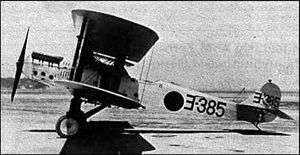Mitsubishi B1M
| B1M | |
|---|---|
 | |
| Role | Torpedo bomber |
| Manufacturer | Mitsubishi |
| First flight | 1923 |
| Introduction | 1924 |
| Primary user | Imperial Japanese Navy |
| Number built | 443 |
| Variants | Mitsubishi 2MB1 |
The Mitsubishi B1M was a Japanese torpedo bomber of the 1920s, also known as the Navy Type 13 Carrier-Borne Attack Aircraft. It was designed and built by Mitsubishi and used in combat against China.
Development
While working with the Mitsubishi company, the British aircraft designer Herbert Smith designed the 2MT1 two-seat biplane torpedo bomber which flew for the first time in January 1923.[1] It went into Japanese Navy service as the Type 13-1 carrier-borne attack aircraft or B1M1, and was followed by the 2MT2 and 2MT3 variants (also designated B1M1). The redesigned Type 13-2 was designated B1M2. The final version, the Type 13-3 or B1M3, had the company designation 3MT2 and was a three-seater. Total production was 443.[1] The B1M was powered by a 450 hp (340 kW) Napier Lion or Hispano-Suiza engine according to version.
Operational history

The type entered service in 1924 and served into the 1930s, 32 flying from the aircraft carriers Kaga and Hōshō during the Shanghai Incident in 1932.[1] An aircraft from Kaga was lost during an aerial engagement between an American air force adviser and demonstration pilot to the Chinese government, Robert Short, who also lost his life, and regarded as a hero defending the Chinese city against the Japanese aircraft.[2]
From 1929, a number of surplus B1Ms were converted for civilian use, being fitted with an enclosed cabin for passengers or cargo.
Variants
Imperial Japanese Navy Air Service (IJNAS) long formal designations
- Navy Type 13-1 Carrier Attack Aircraft
- B1M1
- Navy Type 13-2 Carrier Attack Aircraft
- B1M2
- Navy Type 13-3 Carrier Attack Aircraft
- B1M3
Navy short designations
- B1M1
- Initial two seat production version powered by 450 hp (340 kW) Napier Lion engine. . 197 built by Mitsubishi.[3]
- B1M2
- Three-seat production torpedo bomber, based on 2MT5, powered by Mitsubishi Hi V-12 engine. 115 built by Mitsubishi.
- B1M3
- Improved B1M2 with revised propeller and reduction gear. 128 built by Mitsubishi and Hiro Naval Arsenal.
Company designations
- 2MT1
- Navy Type 13-1 Carrier Attack Aircraft / B1M1
- 2MT2
- Navy Type 13-1 Carrier Attack Aircraft / B1M1
- 2MT3
- Navy Type 13-1 Carrier Attack Aircraft / B1M1
- 2MT4
- Experimental reconnaissance seaplane version. One built.
- 2MT5
- Prototype of the B1M2 / Navy Type 13-2 Carrier Attack Aircraft, two-seat torpedo bomber powered by 450 hp (340 kW) Mitsubishi Hi V-12 engine (licensed built Hispano-Suiza Lb). One built.
- 3MT1
- Navy Type 13-2 Carrier Attack Aircraft / B1M2
- 3MT2
- Navy Type 13-3 Carrier Attack Aircraft / B1M3
Imperial Japanese Army Air Service (IJAAS) long formal designations
- Mitsubishi Army Type 87 Light Bomber
- Mitsubishi B1Ms used by the IJAAS .
Civilian designations
- T-1.2 Converted Aeroplane
- Civil conversion of B1M. Several variations on type. Enclosed cabin for two or three passengers. Powered by original Lion or Hispano-Suiza engines or converted with licensed built Bristol Jupiter radial engine. Also known as Type 13th Year Converted Aeroplane.[3]
Operators
Specifications (2MT2)
Data from The Encyclopedia of World Aircraft [1]
General characteristics
- Crew: Two
- Length: 9.77 m (32 ft 0¾ in)
- Wingspan: 14.77 m (48 ft 5½ in)
- Height: 3.50 m (11 ft 5¾ in)
- Wing area: 59.0 m² (645 ft²)
- Empty weight: 1,442 kg (3,179 lb)
- Max. takeoff weight: 2,697 kg (5,946 lb)
- Powerplant: 1 × Napier Lion 12 cylinder broad arrow engine, 500 hp (370 kW)
Performance
- Maximum speed: 210 km/h (113 kn, 130 mph)
- Range: km (nm, mi)
- Service ceiling: 4,500 m (14,765 ft)
- Wing loading: 45.7 kg/m² (9.22 lb/ft²)
- Power/mass: 0.14 kW/kg (0.084 hp/lb)
- Endurance: 2.6 hours [3]
Armament
- Guns: 2 × fixed, forward-firing 7.7 mm machine guns and 2 × pivoted 7.7 mm machine guns in rear cockpit
- Ordnance: 1 × 18-inch torpedo or 2 × 240 kg (529 lb) bombs
See also
- Related development
- Aircraft of comparable role, configuration and era
- Related lists
References
- 1 2 3 4 Donald, David (Editor) (1997). The Encyclopedia of World Aircraft. Aerospace Publishing. ISBN 1-85605-375-X.
- ↑ http://www.talesofoldchina.com/shanghai/people/t-short.htm
- 1 2 3 Mikesh, Robert C; Abe, Shorzoe (1990). Japanese Aircraft 1910-1941. London: Putnam Aeronautical Books. ISBN 0-85177-840-2.
External links
| Wikimedia Commons has media related to Mitsubishi B1M. |